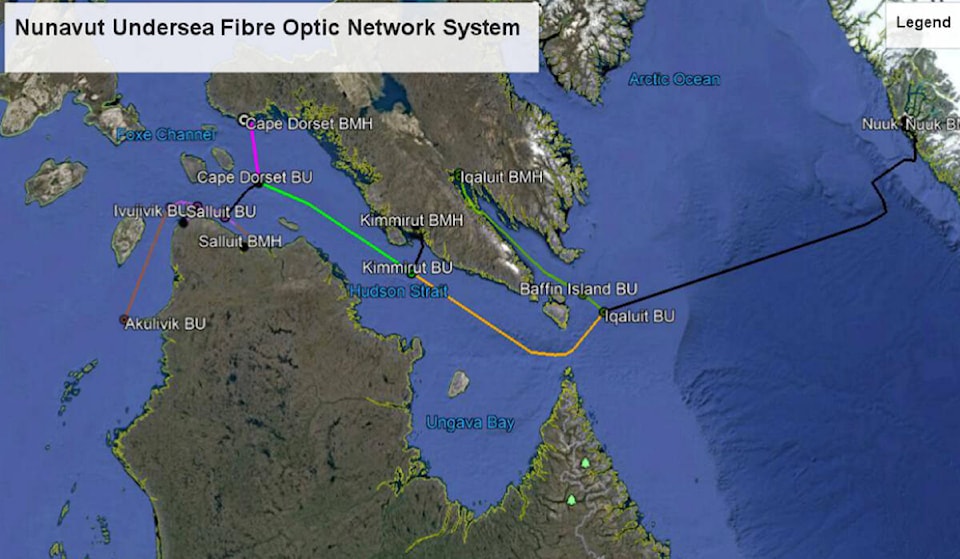The Government of Nunavut’s foray into an undersea internet fibre optic initiative could be rife with cost overruns as the government may be ill-equipped to manage the project, MLA John Main has warned.
“It’s no secret that I have expressed concerns over this project. It’s a major undertaking and I’m concerned about the planning, the management and execution of this project,” said Main, chair of the Standing Committee on Oversight of Government Operations and Public Accounts, while speaking in the legislative assembly on Sept. 13. “I’m concerned that it’s a mega-project and I’m concerned that it could end up being a bit of a project that is larger than we believe due to planning and budgeting issues around this.
“Any time you have governments making investments in information technology, in terms of public accounts, in terms of expenditures, that’s something to keep an eye on very closely and the Nunavut government, in my opinion, is no exception. This needs to be managed very closely,” he said.
The Government of Nunavut has several recent requests for proposals relating to the project in various stages. The federal government announced $151 million in funding for the undersea fibre optic cable project on Aug. 19, 2019. The GN’s contribution was said to be $30 million. At that time, the initiative entailed installing 1,700 kilometres of fibre optic cable underwater from Nuuk, Greenland to Iqaluit through the Davis Strait. Kimmirut would also be connected, bringing faster, more reliable internet to 3,215 households, in addition to schools, businesses, health facilities and government facilities.
“One of my biggest concerns about this project is that, to my knowledge, there is nobody within the Government of Nunavut who is a fibre optics marine cable expert,” Main said. “There is no expertise within the Government of Nunavut. We’re embarking, or the government is hoping to embark, on a project through uncharted waters.”
Finance Minister George Hickes noted that DRG Undersea Consulting is the GN’s primary consultant on this file.
Dan Carlson, deputy minister of Finance, acknowledged that the Eastern Arctic undersea fibre optic network is a “very big project.” He explained that a GN steering committee of senior executives from various departments is overseeing the matter, with the Department of Community and Government Services taking the lead.
Carlson also pointed out that the undersea cable route may now run from Quebec to Nunavut instead of from Greenland.
“We need to figure out which route would make the most sense for Nunavummiut, so which would be most resilient and cost effective,” he said.
The government is aiming to have the underwater fibre optic line in service by spring 2024, he added.
Hickes said construction costs should be known by January 2022.
Main sought confirmation that the next legislative assembly, following the Oct. 25 territorial election, will be facing “major appropriations” to cover the costs of the project.
“Yes,” Hickes replied.
On Sept. 16, Main noted that detailed questions he submitted on July 8 to Community and Government Services Minister Jeannie Ehaloak about the undersea fibre optic project were not answered.
“I am disappointed that my colleagues and I did not receive replies to our correspondence before the end of this assembly, so I am encouraging the government to have updated information ready for tabling in the next assembly concerning the issues that my colleagues and I have raised,” he said.
He also encouraged the GN to consider taking on partners in the initiative, such as an Inuit organization or a private-sector entity “to free up some more capital dollars for our government.”
Hickes replied that the next legislative assembly would have to make any such decision.
“Part of what we’re looking at doing is undersea mapping of western Hudson Bay to potentially link up with a line if it does come up from Manitoba,” he said. “We’re doing our best to cover all our bases and options so that as these opportunities arise — if there are opportunities to partner — then we have all the information available to make an informed decision, or so the sixth (legislative) assembly can make an informed decision.”
Main also asked if the GN is ensuring that it doesn’t duplicate any of the Kivalliq Inuit Association’s efforts as it works towards a Kivalliq Hydro-Fibre Link.
Hickes responded: “Basically in a nutshell, we don’t know exactly what options are going to be available when the decision-making time comes as of this moment, but I will say that the Kivalliq Inuit Association’s initiative and our approach are both the same: we want to make sure that Nunavut communities are connected. If there is an opportunity to partner or to look at enhancing each other’s projects, I’m sure that those opportunities will be explored down the road.”
